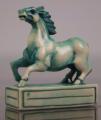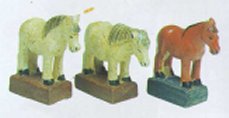Shatar, Mongolian Chess
Shatar is Mongolian Chess, Chess played in the Republic of Mongolia, capital Ulan Bator. A similar form is also played in Tuva, a Russian republic in Siberia and in Inner Mongolia, a province of China People's Republic. In Tuvan, its name is Shydyraa.
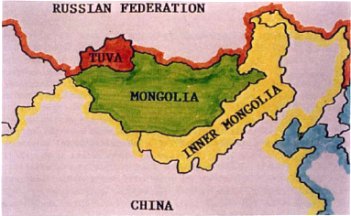
(Map
from R.Pozzi)
Mongolian Shatar sets are beautiful objects, carved by artists. They are really fascinating. Many illustrations are shown on this page. In addition, there is a second page here which presents illustrations kindly provided to me by Rodolfo Pozzi.
This game has been studied by ethnologists several times. Two studies have been particularly taken into account for the making of this page:
Assia Popova, "Analyse formelle et classification des jeux de calculs mongols", in Études Mongoles, Cahier 5, Paris, 1974.
Rodolfo Pozzi, "I giochi di schacchi mongoli riflesso della cultura nomade delle steppe - The Mongolian chess sets reflecting the nomadic culture of the steppes", Chess Collector International, 10th Biennal Convention, Philadelphia, USA, May 2002.
On the Web, there are several pages which can further read:
Lev Kisliouk's pages which gives complete rules and variants. Mirrored here.
Chessvariants.com of course.
The AISE version of Shatar.
A.Karpov's official web site which presents and sells a fantastic carved set in mammoth's bone whose photographs have been reproduced here.
Pages from the Chess Collector International - Italy, where several papers from Rodolfo Pozzi can be found.
Chess is a very popular game among Mongolian people. Shatar is the local form which presents several differences with the International play in term of rules and material.
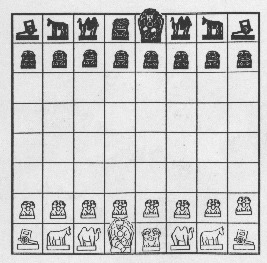
(from
L.Kisliouk)
The Chessboard used to be unicolor until end of WWII when people adopted the classical checkered board, mostly under the influence of Russians. Also, the international rules are now compulsory for official competitions.
Pieces can be carved in stone (agalmatolite or soapstone, marble, steatite), bronze or other metal (speciality of Buriats), horn and even mammoth's bone or ivory!

Mongolian
set from Ulan-Bator (from Assia Popova)
The pieces are very expressive and reflect the current life. Although they are very coloured, the color does not play an important role to distinguish the sides. Only the bases carry significant colors (red or green). The side difference is rather made using a symbolic strong opposition between both sets: aggressive/peaceful, male/female, good/evil, ...
The name of the pieces and their meanings are the following:
|
Name |
meaning |
equivalent |
|
Nojon (Noyion) |
Lord, Chief, Prince |
King |
|
Bers |
Snow panther |
Queen |
|
Temee |
Camel |
Bishop |
|
Mor' (Mori) |
Horse |
Knight |
|
Tereg (Terghe) |
Cart |
Rook |
|
Xüü (Huu) |
Child |
Pawn |
Modern Mongolian Shatar set made from mammoth's bone and sold on A.Karpov web site
Soapstone set in the Soyot (Tuvan) tradition, 1960 (from Williams)
The Nojon: the name goes to the time of Genghis Khan and means a person of distinction. Usually, it is represented seated. Often, one side has an old Nojon while the other has a young one.
The Bers: the name applies to a snow panther. However, it is sometimes represented by another animal wild for one side (tiger, lion) and domestic for the other (dog or even a bull). The lion is unknown in Mongolia but his presence here can be an indication of a Persian origin. Moreover, the choice of Bers could come from a phonetic deformation of the Persian Firz(an) or the Turkish Fers because Mongols do not pronounce the "f". Then it should be seen as Minister or Vizier but not as a Queen.
The Temee: is the hairy Bactrian camel with 2 humps contrary to the Camel in Indian set which has 1 hump only. As a beast of burden and war, it probably took the place of the Elephant, meaningless in those cold countries.
The Mor': is the horse, always riddleless. The importance of the horse in the nomadic life of the Mongolian tribes is naturally highlighted in Shatar. It is forbidden to mate with a Horse.
The Tereg: means a cart. This is remarkable because it is the very first sense of this piece in the earliest forms of Chess. That sense was later on lost by the Arabs and the Persians. Interestingly, that notion is well kept in some Indian sets and in the Chinese Xiangqi. It is possible that the geographical and historical proximity of Mongolia and China is the explanation of this coincidence. In Shatar set, this piece is represented by carriages, portable yurts, modern automobiles (!) or symbols like swastika (here a sun symbol transmitted by Tibetans to Mongolia), spirals, lotus flowers, wheels, knots, peacock tails, lozenges...
The Xüü: means a child and it should be considered like a Bers-to-be. As a matter of fact, when it reaches the eighth rank, it can only promote to a Bers. However, in Shatar set, it can be represented by small animals or various scenes like musicians, prisoners. Often, all Pawns are distinctive carved pieces.
Bronze
set from Tuva, 1920 (from Linder). From top left to bottom right :
Nojons / Garuda mythic bird (Tereg) / Camels / Horse and Pawns
Wooden set from Tuva, 1920 (from Linder). From top left to bottom right : Nojons / Bers / Camels / Horses / Carts and Cars / Pawns
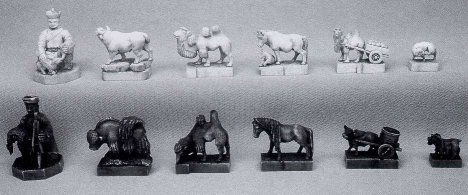
Ivory
set from Tuva (from Sanvito)
DISCUSSION
Because of its rules and because it uses 3D carved pieces, Shatar is obviously related to Indo-Persian forms of Chess rather than to Chinese Xiangqi.
Beyond that, what is its exact lineage ? The spiritual and cultural contact between Tibet and Mongolia is very tight. Altan Khan officially converted Mongolia to Buddhism in 1576 under the form of the Tibetan Lamaism. Altan Khan gave to Sonam Gyamtso the title of Dalaï-lama, which is a Mongolian word and not a Tibetan one (it means ocean lama, i.e. universal lama). Then, many Tibetan monks came to Mongolia to instruct the people. They still follow this religion nowadays.
Then, it is not surprising to learn that Mongols play Dörvölzh, a kind of Weiqi/Go, over a 17x17 board, exactly like the Tibetan do/did with their Mig Mang. Therefore, one might expect that Shatar, Mongolian Chess, has been inspired by Tibetan Chandraki.
However, this assumption is suspect because there is no many elements to confirm it. Then, it is possible, and mostly probable, that the Mongols took their Chess directly from their conquest and occupation of Persian lands (in Central Asia and in Iran). We have seen that the study of the name and the representation of the pieces gives some clues to support this hypothesis.
RULES
It seems that the traditional arrangement was with Nojon at the right of the Bers for both sides. Now, many are playing with aligned Nojons like in conventional Chess.
The moves are orthodox except the following:
When Nojons are not facing on the same file, no Pawn can move two steps. But when the Nojons are facing, the first move must be advancing the Bers' Pawn two steps. Only this Pawn has the right to move two steps at its first move.
There is neither castling nor en-passant.
A Pawn reaching the last rank is promoted to a Bers (only). There is no other promotion. There is no restriction on the promotion.
Depending of the period at which the game is played, the Bers presents differents moves. One is the orthodox but for the other one, the Bers slides like a Rook or moves 1 step in diagonal only. (Like a Dragon King in Shogi).
It is reported that in some variants, the Camel could move diagonally 1-3 squares (otherwise, it moves like a Bishop) (Lev Kisliouk).
Assia Popova gives those two supplementary rules:
The Horse can move like an Amazon (i.e. Queen+Knight) from its second move.
When a King reaches the home rank of its enemy, it can move as a Knight in addition. (It should be very difficult to mate then...).
(It is not said if these intriguing moves also apply to the capture mode. Maybe not).
There are different ways of checking:
Shak given by a Bers, a Cart or an Horse,
Tuk given by a Camel,
Tsod given by a Pawn.
It is strictly forbidden to mate with an Horse.
To win, it is compulsory to mate from a Shak (of Bers or Cart) or by a succession of check containing a Shak.
All other mate are called Niol. A Niol is a draw.
If a player loses all his piece except his King, it is a draw called Robado.
A King who can not move without putting himself in prise (stalemate) has lost as it is unimaginable for this nomadic people to loose his freedom of move. (rule indicated by R.Pozzi).
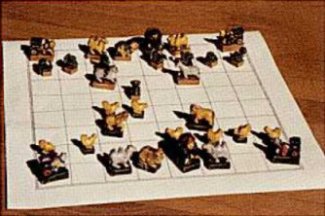
(from
R.Pozzi)
Find the rules of Shatar, the Mongolian Chess, on chessvariants.com
LARGE VARIANT
Beside the regular Shatar game played on a 8x8 board, there is also Hiashatar, a Great Chess played on a 10x10 board.
















